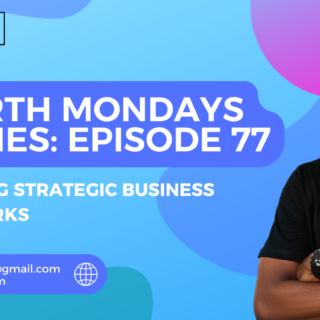Industry Ecosystem Development
North Mondays Series: Episode 78

Ever wonder how industry leaders stay ahead of the curve? It’s not just about innovation; it’s about building and nurturing ecosystems that fuel growth and long-term success. Whether you’re a startup founder or part of a large corporation, developing an industry ecosystem can open doors to new opportunities, partnerships, and markets.
Industry ecosystems aren’t just buzzwords. They are interconnected networks of organizations—suppliers, partners, distributors, and even competitors—working together to create value. The stronger and more diverse your ecosystem, the more resilient and innovative your business can be. In today’s episode of the North Mondays Series, we’ll dive into the concept of Industry Ecosystem Development, exploring how businesses can tap into these networks for mutual benefit and growth.
Imagine being able to leverage the expertise, technology, and market access of other organizations to fast-track your own business development. That’s the power of building a solid ecosystem. Today, we’ll show you how to align your business with key players in your industry and create value that benefits everyone involved.
Ready to learn how to thrive by developing your own industry ecosystem? In Episode 78, we’ll break down the steps to establish and scale an ecosystem, including identifying strategic partners, building relationships, and fostering collaboration. Don’t miss this chance to unlock new avenues for growth and innovation. Let’s explore how to build and sustain a thriving industry ecosystem.
Introduction: Why Industry Ecosystems Matter for Business Growth
Welcome to Episode 78 of the North Mondays Series! In today’s competitive landscape, businesses rarely succeed in isolation. The most successful companies have learned the importance of developing and nurturing an industry ecosystem that provides access to new technologies, partnerships, and customer bases. This approach can help you scale faster, innovate more effectively, and create a lasting competitive advantage.
An industry ecosystem is a network of businesses, organizations, and stakeholders working together to create shared value. It goes beyond traditional supplier relationships, focusing on collaboration, knowledge sharing, and innovation.
Understanding Industry Ecosystems: The Foundation for Collaboration
An industry ecosystem is not a supply chain. It’s a web of interconnected entities, all contributing to each other’s success. The ecosystem model allows for a higher level of collaboration, where organizations can share resources, expertise, and market access, reducing risk and increasing innovation potential.
Why this matters for your business:
- Encourages collaboration across industries and sectors.
- Creates a support system for innovation and development.
- Opens doors to new markets and technologies through partnerships.
Identifying Strategic Partners: Who Should Be Part of Your Ecosystem?
The first step in developing an industry ecosystem is identifying the right partners. This might include suppliers, distributors, technology providers, startups, or even competitors who can offer complementary services or innovations. The key is to find partners who share your vision and can bring unique value to the table.
Key considerations for identifying strategic partners:
- Complementary strengths: Look for organizations that can fill gaps in your offerings.
- Shared values: Alignment in mission and goals ensures smoother collaboration.
- Mutual benefit: Ensure there’s value on both sides of the partnership to create a win-win situation.
Building Relationships: The Cornerstone of Ecosystem Development
Once you’ve identified potential partners, the next step is building strong relationships. Collaboration thrives on trust, clear communication, and shared goals. Regular engagement and co-creation opportunities help foster these relationships and keep the ecosystem growing.
Tips for building strong ecosystem relationships:
- Open communication: Keep lines of communication clear and transparent.
- Joint innovation: Work together on projects that benefit both parties.
- Long-term mindset: Focus on building lasting relationships rather than short-term gains.
Fostering Innovation Through Collaboration
A well-developed ecosystem encourages innovation. By working closely with different partners, you can tap into new technologies, ideas, and business models. This collaboration accelerates product development, improves service offerings, and opens up new markets.
How ecosystems foster innovation:
- Cross-pollination of ideas: Partners from different industries bring new perspectives.
- Shared resources: Access to advanced technologies and expertise without significant investment.
- Faster time-to-market: Co-development can speed up product launches and reduce costs.
Scaling Your Ecosystem: Expanding Reach and Impact
As your ecosystem matures, focus on scaling it by bringing in new partners, expanding into new markets, and exploring additional industries. Scaling doesn’t just mean more partners; it’s about deepening relationships and broadening the scope of collaboration.
Steps to scaling your industry ecosystem:
- Diversify partnerships: Don’t limit yourself to one sector; explore adjacent industries.
- Global outreach: Look beyond local markets for international collaboration opportunities.
- Continuous engagement: Maintain momentum with regular touchpoints and co-creation efforts.
Measuring Success: How to Evaluate the Impact of Your Ecosystem
To ensure your ecosystem is creating value, you need to measure its impact. Key metrics might include new product launches, revenue growth from ecosystem partnerships, cost savings through shared resources, and the strength of relationships with your partners.
Metrics to assess the success of your ecosystem:
- Innovation output: Number of new products or services launched through partnerships.
- Revenue growth: Increase in revenue attributed to ecosystem collaborations.
- Partnership longevity: The duration and strength of relationships within the ecosystem.
Conclusion: Start Building Your Industry Ecosystem Today
Building an industry ecosystem takes time, effort, and strategic vision, but the rewards can be significant. By leveraging a network of partners, you can unlock new opportunities for growth, innovation, and market expansion. Whether you’re a startup or an established business, focusing on ecosystem development is a powerful strategy to stay competitive and resilient in today’s rapidly changing markets.
Ready to take the leap? Start identifying strategic partners today and begin the journey of building a thriving ecosystem that can propel your business forward.
Don’t forget to check out my online course, “Biz Dev with Nnanna,” for more in-depth strategies on ecosystem development and business growth!
#IndustryEcosystem #BusinessDevelopment #NorthMondays #BizDevWithNnanna #Collaboration #Innovation #StartupGrowth
FAQs
What is an industry ecosystem?
An industry ecosystem is a network of interconnected organizations—such as suppliers, partners, customers, and even competitors—working together to create shared value. This collaboration fosters innovation, reduces risks, and opens up new business opportunities.
Why are industry ecosystems important for business growth?
Industry ecosystems allow businesses to leverage the strengths of multiple organizations, fostering collaboration and innovation. This creates a more resilient business environment where companies can access new markets, technologies, and expertise, driving growth and competitive advantage.
How do you build an industry ecosystem?
Building an industry ecosystem starts with identifying strategic partners who share your vision and offer complementary strengths. Next, foster strong relationships through open communication and joint projects. Finally, focus on scaling the ecosystem by adding new partners and expanding into new markets.
How does an industry ecosystem foster innovation?
By bringing together organizations from different sectors or industries, an ecosystem facilitates the cross-pollination of ideas and technologies. This collaboration can lead to faster product development, new business models, and access to cutting-edge resources, all of which drive innovation.
How do you scale an industry ecosystem?
Scaling an ecosystem involves expanding your partnerships, reaching into new markets, and diversifying the industries you collaborate with. The goal is to deepen relationships while continuously engaging with new partners to create broader value across the network.










Recent Comments